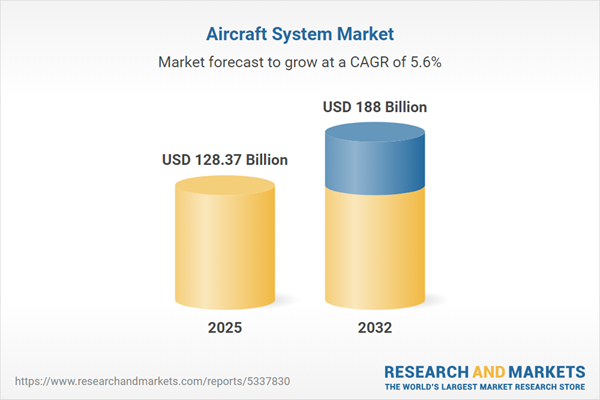Speak directly to the analyst to clarify any post sales queries you may have.
The aircraft system market is undergoing significant transformation, challenging aviation leaders to align operations with today’s regulatory, technological, and environmental demands. As sector complexity intensifies, executives need actionable insights to guide resilient and strategic decision-making.
Market Snapshot: Aircraft System Market Size and Growth Drivers
The aircraft system market reached a valuation of USD 121.47 billion in 2024 and is expected to rise to USD 128.37 billion in 2025. Forecasts project the market to expand further, reaching USD 188 billion by 2032, corresponding to a compound annual growth rate (CAGR) of 5.61%. This expansion is driven by the accelerated integration of smart avionics, advancements in propulsion technologies, and the optimization of subsystems across civil and defense fleets. Shifting regulatory requirements focusing on safety and sustainability prompt organizations to recalibrate priorities, while ongoing investments in infrastructure and supply chain stability ensure compliance and competitive agility.
Scope & Segmentation of the Aircraft System Market
- Avionics: Efficient, secure communication and real-time data management are central to enabling digital cockpit initiatives and ensuring cohesive workflows for a wide range of aircraft.
- Electrical Architectures: Systems supporting robust power generation and streamlined distribution are vital to both legacy and new electric aircraft platforms, enabling energy-efficient upgrades.
- Environmental Control: Sophisticated temperature, climate, and pressure management solutions create optimal cabin and equipment conditions, fostering safety and enhanced passenger experience.
- Fuel Systems: Technologies delivering precise fuel storage and metering are essential for supporting sustainability initiatives and meeting intensifying emissions regulations.
- Hydraulic Sub-Systems: High-precision pumps and actuators sustain aircraft maneuverability and reliability, underpinning consistent performance across varied operational profiles.
- Landing Gear: Engineered gear assemblies offer versatility for takeoffs and landings across different terrains, improving lifecycle safety and adaptability for diverse fleet needs.
- Propulsion Technologies: Innovations in engine types, including turbofan and turboshaft variants, respond to evolving mission requirements and environmental standards.
- Platforms: Business jets, commercial airliners, military aircraft, rotorcraft, and UAVs require customized system integration strategies for both new production and retrofit markets.
- Applications: Integration projects—whether new build or retrofit—foster ongoing asset value and enable incremental fleet improvements.
- Distribution Channels: Original equipment manufacturers (OEMs) and aftermarket providers deliver comprehensive support, assisting operators with global asset management.
- End Users: Stakeholders such as airlines, lessors, defense agencies, and private operators adopt integrated systems that address diverse operational and mission-driven demands efficiently.
- Regions: North America, South America, Europe, Middle East & Africa, and Asia-Pacific exhibit distinct growth drivers, regulatory landscapes, and localized market approaches.
- Key Companies: Major industry leaders—Honeywell International Inc., General Electric Company, Collins Aerospace, Safran S.A., Thales S.A., BAE Systems plc, Parker-Hannifin Corporation, Eaton Corporation plc, Moog Inc., and Liebherr-Aerospace Lindenberg GmbH—advance market innovation and foster collaborative technology development.
Key Takeaways for Senior Decision-Makers
- Software-defined avionics and modular designs accelerate systems integration, increasing adaptability for operators facing mission and fleet variation.
- Emerging electrification strategies—such as hybrid and next-generation propulsion—address stricter sustainability mandates and enhance operational efficiency at scale.
- Investments in localized manufacturing and additive technologies help mitigate disruption, strengthen regional value chains, and stabilize supply continuity.
- Predictive maintenance tools integrated with robust aftermarket support infrastructure minimize downtime, improve asset utilization, and provide cost transparency across the fleet lifecycle.
- Strategic partnerships between traditional equipment manufacturers and niche technology providers support compliance objectives and enable faster adoption of innovation.
- The formation of dedicated innovation hubs enables more rapid digital transformation and supports growth in technologically advanced aircraft system segments.
Tariff Impact: Managing the Effects of US Trade Policy Shifts
Recent shifts in US trade policy have increased supply chain complexity for the aircraft system market. Organizations are responding by intensifying localized sourcing efforts, building resilient regional partnerships, and strengthening OEM and aftermarket channel access. This approach safeguards procurement operations, reduces external risk, and preserves lifecycle management agility even as policy environments change.
Methodology & Data Sources
This analysis employs a multifaceted methodology, integrating executive interviews, scientific research, proprietary market data, patent intelligence, and regulatory review. Data validation through triangulation and stakeholder engagement ensures the accuracy and relevance of insights into technological evolution and market dynamics.
Why This Report Matters
- Delivers actionable intelligence on sector technology shifts, supply network changes, and regulatory developments within the aircraft system market.
- Supports informed procurement and investment planning using tailored recommendations for diverse platforms, regions, and end-user requirements.
- Enables aviation leaders to align digital and sustainability strategies with evolving operational priorities, driving long-term excellence.
Conclusion
This report equips decision-makers with clear, strategic guidance required to implement resilient planning, encourage targeted innovation, and navigate continual change in the aircraft system marketplace.
Additional Product Information:
- Purchase of this report includes 1 year online access with quarterly updates.
- This report can be updated on request. Please contact our Customer Experience team using the Ask a Question widget on our website.
Table of Contents
3. Executive Summary
4. Market Overview
7. Cumulative Impact of Artificial Intelligence 2025
Companies Mentioned
The companies profiled in this Aircraft System market report include:- Honeywell International Inc.
- General Electric Company
- Collins Aerospace, Inc.
- Safran S.A.
- Thales S.A.
- BAE Systems plc
- Parker-Hannifin Corporation
- Eaton Corporation plc
- Moog Inc.
- Liebherr-Aerospace Lindenberg GmbH
Table Information
| Report Attribute | Details |
|---|---|
| No. of Pages | 194 |
| Published | October 2025 |
| Forecast Period | 2025 - 2032 |
| Estimated Market Value ( USD | $ 128.37 Billion |
| Forecasted Market Value ( USD | $ 188 Billion |
| Compound Annual Growth Rate | 5.6% |
| Regions Covered | Global |
| No. of Companies Mentioned | 11 |









